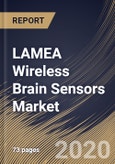The Latin America, Middle East and Africa Wireless Brain Sensors Market is expected to witness market growth of 13.9% CAGR during the forecast period (2020-2026).
The presence of a large target population and high unfulfilled requirements, concerning minimally invasive procedures, is anticipated to present huge development possibilities for the leading players working in the market for wireless brain sensors. Besides, an expansion in the number of clinical trials and high investments in R&D by global market players, due to the low-cost services in the region are some of the leading drivers of the market for wireless brain sensors. An expansion in the number of road accidents, government activities, and advancements in the clinical development structure of emerging economies are some other components supporting market development in this region.
A few of the significant proceedings for brain sensors are high frequency of neurological problems because of hectic lifestyles, expanding anxiety, and extreme varieties in the social conditions that have aggregately intensified the demand for the wireless brain-sensing market. The expansion of patient experiencing brain-related disorder also propel the development of the wireless brain-sensing market. The expanding prevalence of neurological issues is anticipated to enhance market development. Severe brain injuries spur the greatest demand for wireless brain sensors. Likewise, higher occurrence rates of different neurological issues, high anxiety levels have prompted an increasing demand for wireless brain sensors hence encapsulating this market.
Based on End Use, the market is segmented into Multispecialty hospitals, Research institutes and Others. Based on Product, the market is segmented into Electroencephalography (EEG) Devices, Sleep Monitoring Devices, Intracranial Pressure (ICP) Monitors, Transcranial Doppler (TCD) Devices and Others. Based on Application, the market is segmented into Traumatic Brain Injuries, Parkinson's Disease, Epilepsy, Dementia and Others. Based on countries, the market is segmented into Brazil, Argentina, UAE, Saudi Arabia, South Africa, Nigeria, and Rest of LAMEA.
The market research report covers the analysis of key stake holders of the market. Key companies profiled in the report include Novo Nordisk A/S, Koninklijke Philips N.V., Natus Medical Incorporated, Neuroelectrics, Brain Products GmbH, NeuroSky, Inc., Advanced Brain Monitoring, Inc., Hangzhou Zhongheng Electric Co., Ltd., Neuronetrix Solutions, LLC and EMOTIV, Inc.
Scope of the Study
Market Segmentation:
By End Use
By Product
By Application
By Country
Companies Profiled
Unique Offerings from the Publisher
The presence of a large target population and high unfulfilled requirements, concerning minimally invasive procedures, is anticipated to present huge development possibilities for the leading players working in the market for wireless brain sensors. Besides, an expansion in the number of clinical trials and high investments in R&D by global market players, due to the low-cost services in the region are some of the leading drivers of the market for wireless brain sensors. An expansion in the number of road accidents, government activities, and advancements in the clinical development structure of emerging economies are some other components supporting market development in this region.
A few of the significant proceedings for brain sensors are high frequency of neurological problems because of hectic lifestyles, expanding anxiety, and extreme varieties in the social conditions that have aggregately intensified the demand for the wireless brain-sensing market. The expansion of patient experiencing brain-related disorder also propel the development of the wireless brain-sensing market. The expanding prevalence of neurological issues is anticipated to enhance market development. Severe brain injuries spur the greatest demand for wireless brain sensors. Likewise, higher occurrence rates of different neurological issues, high anxiety levels have prompted an increasing demand for wireless brain sensors hence encapsulating this market.
Based on End Use, the market is segmented into Multispecialty hospitals, Research institutes and Others. Based on Product, the market is segmented into Electroencephalography (EEG) Devices, Sleep Monitoring Devices, Intracranial Pressure (ICP) Monitors, Transcranial Doppler (TCD) Devices and Others. Based on Application, the market is segmented into Traumatic Brain Injuries, Parkinson's Disease, Epilepsy, Dementia and Others. Based on countries, the market is segmented into Brazil, Argentina, UAE, Saudi Arabia, South Africa, Nigeria, and Rest of LAMEA.
The market research report covers the analysis of key stake holders of the market. Key companies profiled in the report include Novo Nordisk A/S, Koninklijke Philips N.V., Natus Medical Incorporated, Neuroelectrics, Brain Products GmbH, NeuroSky, Inc., Advanced Brain Monitoring, Inc., Hangzhou Zhongheng Electric Co., Ltd., Neuronetrix Solutions, LLC and EMOTIV, Inc.
Scope of the Study
Market Segmentation:
By End Use
- Multispecialty hospitals
- Research institutes
- Others
By Product
- Electroencephalography (EEG) Devices
- Sleep Monitoring Devices
- Intracranial Pressure (ICP) Monitors
- Transcranial Doppler (TCD) Devices
- Others
By Application
- Traumatic Brain Injuries
- Parkinson's Disease
- Epilepsy
- Dementia
- Others
By Country
- Brazil
- Argentina
- UAE
- Saudi Arabia
- South Africa
- Nigeria
- Rest of LAMEA
Companies Profiled
- Novo Nordisk A/S
- Koninklijke Philips N.V.
- Natus Medical Incorporated
- Neuroelectrics
- Brain Products GmbH
- NeuroSky, Inc.
- Advanced Brain Monitoring, Inc.
- Hangzhou Zhongheng Electric Co., Ltd.
- Neuronetrix Solutions, LLC
- EMOTIV, Inc.
Unique Offerings from the Publisher
- Exhaustive coverage
- Highest number of market tables and figures
- Subscription based model available
- Guaranteed best price
- Assured post sales research support with 10% customization free
Table of Contents
Chapter 1. Market Scope & Methodology
Chapter 2. Market Overview
Chapter 3. LAMEA Wireless Brain Sensors Market by End Use
Chapter 4. LAMEA Wireless Brain Sensors Market by Product
Chapter 5. LAMEA Wireless Brain Sensors Market by Application
Chapter 6. LAMEA Wireless Brain Sensors Market by Country
Chapter 7. Company Profiles
Companies Mentioned
- Novo Nordisk A/S
- Koninklijke Philips N.V.
- Natus Medical Incorporated
- Neuroelectrics
- Brain Products GmbH
- NeuroSky, Inc.
- Advanced Brain Monitoring, Inc.
- Hangzhou Zhongheng Electric Co., Ltd.
- Neuronetrix Solutions, LLC
- EMOTIV, Inc.
Methodology

LOADING...








